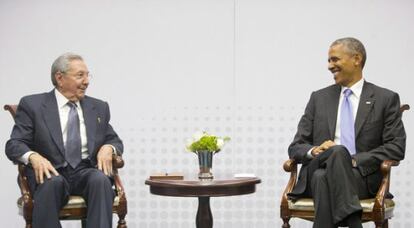US and Cuba announce the reopening of their embassies
July 20 set as date for reestablishment of formal diplomatic relations after 54 years


The United States and Cuba have reached an agreement “to reestablish diplomatic relations and reopen their embassies,” a symbolic step in the process to normalize relations that began more than six months ago.
The date fixed is July 20, according to a letter from President Barack Obama that was handed to his Cuban counterpart Raúl Castro in Havana.
Secretary of State John Kerry is set to travel to the Cuban capital later this month to raise the US flag outside the embassy on the Malecón, Obama announced on Wednesday.
The two opening ceremonies are unlikely to take place simultaneously
July 20 is the date that has been set for the reestablishment of formal diplomatic relations, rather than the day when Kerry will likely set foot on the island, becoming the first US state secretary to do so since 1945.
State Department sources clarified on Wednesday that the reopening of embassies will take place from this date onwards. For protocol reasons, the two opening ceremonies are unlikely to take place simultaneously, or on the same day.
Jeffrey DeLaurentis, the chief of the US Interests Section in Havana, gave Cuban interim Foreign Minister Marcelino Medina the letter from Obama first thing on Wednesday morning, and Medina revealed the date set out in the message a short time later.
The gesture was reciprocated by the chief of the Cuban Interests Section in Washington, José Ramón Cabañas Rodríguez, who handed a similar letter from Castro to Obama to US Deputy Secretary of State Antony Blinken.
The announcement, which has been expected for the last two weeks, confirms the parties’ desire to move forward in the process to normalize relations that Obama and Castro began on December 17.
Seven months of diplomatic reset
- December 17, 2014: US President Barack Obama and his Cuban counterpart Raúl Castro simultaneously announce their decisions to renew diplomatic relations.
- January 21, 2015: United States Assistant Secretary of State for Western Hemisphere Affairs Roberta Jacobson travels to Havana to hold the first meeting to begin the process toward normalizing diplomatic relations.
- April 11, 2015: Obama and Castro meet at the Summit of the Americas in Panama.
- May 29, 2015: The United States removes Cuba from its list of state sponsors of terrorism.
This historic step comes after four rounds of negotiations between high-ranking officials in Havana and Washington. Obama and Castro also held a historic meeting at the Summit of the Americas in Panama in April, the first formal face-to-face encounter between the leaders of the two nations in more than half a century.
Cuba’s removal from the US State Department’s list of state sponsors of terrorism in late May was another important step toward reopening embassies, given that this had been one of Cuba’s main demands.
Before embassies open, US law requires President Obama to give Congress at least 15 days’ notice of his intention to change the status of the diplomatic mission. Since the White House is not obligated to make this maneuver public, it remains unknown whether Congress has been notified. Both Washington and Havana must also notify Switzerland, which has acted as their diplomatic liaison over the last few decades, of this change.
Naming a new ambassador should present no immediate obstacle, even though lawmakers such as presidential candidate and Senator Marco Rubio, who stand firmly opposed to normalizing relations with Cuba, have threatened to block all nominations for the post. The current representative at the US Interests Section in Havana will remain in office until Congress confirms the new nominee.
Rumors about the imminent reopening of embassies spread after the Cuban Interests Section in Washington, which operates out of the Swiss embassy – Switzerland also serves as host to the US Interests Section in Havana – ceremoniously put up a flagpole at the entrance to Cuba’s former embassy in the US capital on June 10. The historic building has also undergone refurbishment work over the last weeks. In Havana, the US Interests Section fixed and painted its flagpole a few months ago.
Naming an ambassador should not present an obstacle, even though some lawmakers have threatened to block all nominations
Still, the announcement may have been delayed because of Secretary of State Kerry’s cycling accident in Switzerland in late May, which kept him away from his official duties for several weeks. Kerry had openly expressed his wish to attend the raising of the Stars and Stripes over the old US embassy on the Malecón. That office closed in 1961 and it took 16 years for the Interests Section to open after the Jimmy Carter administration signed an agreement with Havana.
Though it has not been said, Pope Francis’s upcoming visit to both the United States and Cuba in September may have served as an incentive to close the deal to reopen the embassies. The Vatican was a key mediator in the long secret negotiations between Washington and Havana and the reopening of the embassies is the most visible indication of the success of those efforts.
Translation: Dyane Jean François
Tu suscripción se está usando en otro dispositivo
¿Quieres añadir otro usuario a tu suscripción?
Si continúas leyendo en este dispositivo, no se podrá leer en el otro.
FlechaTu suscripción se está usando en otro dispositivo y solo puedes acceder a EL PAÍS desde un dispositivo a la vez.
Si quieres compartir tu cuenta, cambia tu suscripción a la modalidad Premium, así podrás añadir otro usuario. Cada uno accederá con su propia cuenta de email, lo que os permitirá personalizar vuestra experiencia en EL PAÍS.
¿Tienes una suscripción de empresa? Accede aquí para contratar más cuentas.
En el caso de no saber quién está usando tu cuenta, te recomendamos cambiar tu contraseña aquí.
Si decides continuar compartiendo tu cuenta, este mensaje se mostrará en tu dispositivo y en el de la otra persona que está usando tu cuenta de forma indefinida, afectando a tu experiencia de lectura. Puedes consultar aquí los términos y condiciones de la suscripción digital.
Últimas noticias
How Japan is trying to avert ‘digital defeat’
From digital curfews to blocking apps: How technology experts protect their children online
Why the price of coffee has skyrocketed: from Brazilian plantations to specialty coffee houses
Confined to a Cuban hospital: When electricity is a matter of life or death
Most viewed
- Why we lost the habit of sleeping in two segments and how that changed our sense of time
- Trump’s obsession with putting his name on everything is unprecedented in the United States
- Pablo Escobar’s hippos: A serious environmental problem, 40 years on
- The Florida Keys tourist paradise is besieged by immigration agents: ‘We’ve never seen anything like this’
- Charles Dubouloz, mountaineering star, retires at 36 with a farewell tour inspired by Walter Bonatti








































